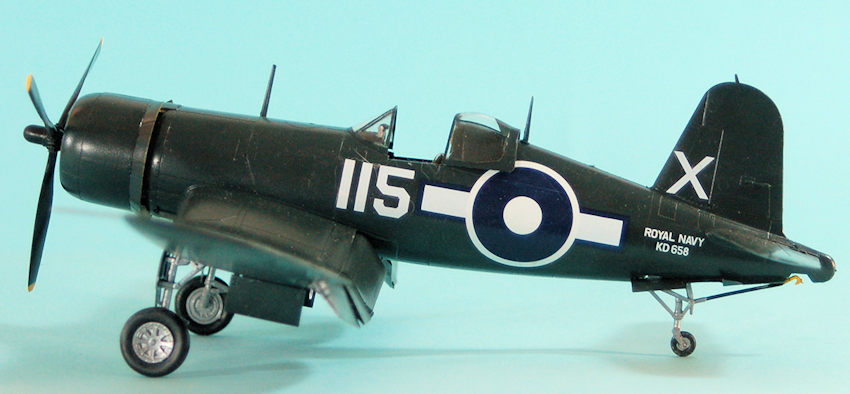
Tamiya 1/48 Corsair IV
| KIT #: | 81070 |
| PRICE: | $31.95 |
| DECALS: | Three options |
| REVIEWER: | Tom Cleaver |
| NOTES: | Aeromaster 48-400 “Royal Navy Corsairs of the British East Indies and Pacific Fleets, Part 1" |

| HISTORY |
The Fleet Air Arm was interested in the Corsair as soon as they heard about it, and began receiving Corsairs under Lend-Lease in 1943. At a time when the U.S. Navy was declaring the Corsair unsuitable for operations aboard an Essex-class carrier, the Fleet Air Arm was operating unmodified Corsair Is (Vought-built F4U-1 “birdcage”) off of CVEs in training - and these did not have the stall warning strip on the right wing or the “de-bounced” landing gear! The British quickly learned that the “same airplane” from different manufacturers was not necessarily the “same” airplane. The Corsair II, which was the version that first saw combat in April 1944, was the Goodyear-built FG-1A. The Corsair III, used in training to supplement the Corsair Is, was the Brewstewr-built F3A-1, while the Corsair IV was the Goodyear-built FG-1D.
The British Corsairs first saw combat during the Tirpitz strikes in April 1944. A matter of a few weeks later, the Corsair first appeared in the Indian Ocean. The Corsair found its primary area of combat in the Indian Ocean and the Pacific from then on.
The Forgotten Fleet:
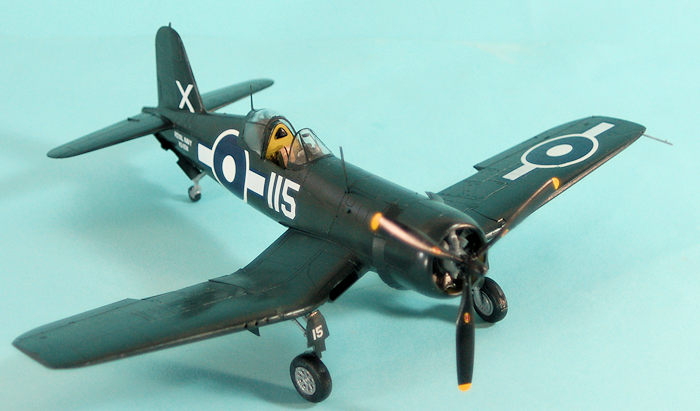 The Royal Navy had
been almost completely driven from the Indian Ocean in March and April, 1942,
when
Kido Butai,
the fast carrier striking force of the Imperial Japanese Navy, had struck the
Royal Navy base at Trincomalee, and also sank HMS
Hermes,
the only British aircraft carrier in the region. Earlier, the Royal Navy had
already been forced to retreat from its main Asian base at Singapore. With the
capture by the Japanese of the Andaman Islands off Malaya shortly after the fall
of Singapore, the main elements of the fleet retreated to Addu Atoll in the
Maldives. Admiral Nagumo’s successful strikes at Trincomalee made the situation
in South Asia so dire with the Japanese advance on India through Burma that
Prime Minister Churchill feared a successful invasion of Ceylon would allow the
Japanese to link up with the German army that was storming through the Libyan
desert in North Africa and looking like it could push the British Eighth Army
out of Egypt and advance into the Middle East. Surface forces could no longer
operate in the central Indian Ocean and the Royal Navy was forced to retreat to
the east coast of Africa and operate from Mombasa, Kenya.
The Royal Navy had
been almost completely driven from the Indian Ocean in March and April, 1942,
when
Kido Butai,
the fast carrier striking force of the Imperial Japanese Navy, had struck the
Royal Navy base at Trincomalee, and also sank HMS
Hermes,
the only British aircraft carrier in the region. Earlier, the Royal Navy had
already been forced to retreat from its main Asian base at Singapore. With the
capture by the Japanese of the Andaman Islands off Malaya shortly after the fall
of Singapore, the main elements of the fleet retreated to Addu Atoll in the
Maldives. Admiral Nagumo’s successful strikes at Trincomalee made the situation
in South Asia so dire with the Japanese advance on India through Burma that
Prime Minister Churchill feared a successful invasion of Ceylon would allow the
Japanese to link up with the German army that was storming through the Libyan
desert in North Africa and looking like it could push the British Eighth Army
out of Egypt and advance into the Middle East. Surface forces could no longer
operate in the central Indian Ocean and the Royal Navy was forced to retreat to
the east coast of Africa and operate from Mombasa, Kenya.
Following the successful invasion of Sicily, which removed the primary Axis threat to the Mediterranean sea lanes, it was possible for the Royal Navy to begin planning a more forceful return to the Indian Ocean. With American forces liberating British territories in the Pacific and extending U.S. influence throughout the region, it became a political and military imperative in the British armed services that a British presence be restored in the Pacific and British naval forces be deployed against Japan. Many in His Majesty’s Government were determined that British territories, such as Hong Kong, should be liberated by British forces. However, this was not a unanimous opinion. Prime Minister Churchill, in particular was opposed to the idea since he did not wish to be seen as a visibly junior partner in what had been exclusively an American war.
HMS Illustrious was the first carrier to arrive in Ceylon in January 1944. In March 1944,the battlecruiser HMS Renown and battleships HMS Howe, Queen Elizabeth and Valiant joined Illustrious to rendezvous with the U.S. Navy’s Task Force 58.5, composed of USS Saratoga (CV-3) and three destroyers which had been detached from Task Force 58 following the successful invasion of Kwajalein for the purpose of training the British in
U.S. operating
procedures.
Illustrious
embarked 1830 and 1833 Squadrons which were equipped with the Corsair II.
Following several weeks of training that gave a marked improvement to the FAA
aircrews, the
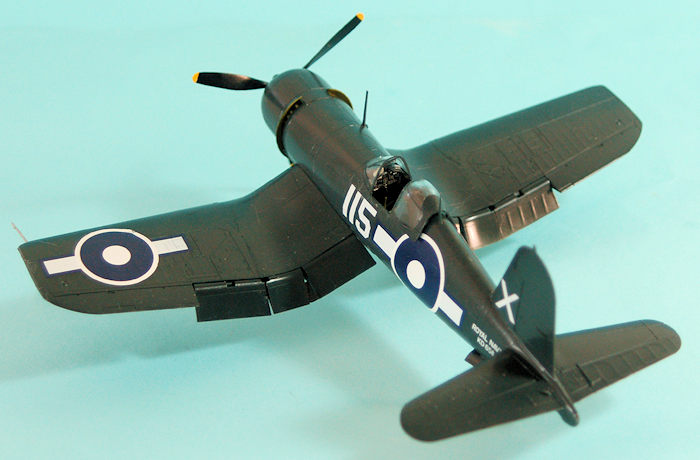 combined Anglo-American fleet struck the Japanese oil port on Sabang Island off northern Sumatra, in Operation Cockpit on 19 April. The
Japanese had no warning of the attack and the port facilities were heavily
damaged.
combined Anglo-American fleet struck the Japanese oil port on Sabang Island off northern Sumatra, in Operation Cockpit on 19 April. The
Japanese had no warning of the attack and the port facilities were heavily
damaged.
The Indonesian oil refineries on Sumatra and Java were of supreme importance to Japan, since they were the source of all aviation gasoline for the Imperial air forces. The remote locations of the captured refineries in Sumatra permitted their operation by the Japanese with impunity from Allied attack from any land bases. With the success of Operation Cockpit, the Anglo-American fleet opened a campaign against the refineries with Operation Transom, which successfully struck the refinery at Surabaya, Java, in 17 May, surprising the Japanese who offered little opposition and severely damaging the installations.
In August 1944, the East Indies Fleet was founded when Admiral Sir James Somerville, who had commanded the fleet since 1942, struck his flag at Trincomalee Naval Base as Commander in Chief of the Eastern Fleet and Admiral Sir Bruce Fraser, former commander of the Home Fleet, raised his flag. During the course of the summer of 1944, HMS Victorious joined the fleet in July, followed by HMS Indomitable in August and HMS Indefatigable in September. With the arrival of the carriers, the East Indies Fleet was given the task of striking the refineries since the carriers could strike with less warning and greater accuracy than the long-range land-based bombers that had attempted strikes before.
On 21 July, as part of Operation Crimson, the British capital ships closed on Sabang Island and shelled the port under air cover by Illustrious and the recently-arrived Victorious which brought additional fighter cover to her 47 Naval Fighter Wing Corsairs with the addition of the newcomers of 1837 and 1838 Squadrons. Naval aviators trained as gunfire spotters directed the fire of the 12 battleships and cruisers, which inflicted heavy damage on the oil facility.
On 25 August, Victorious and Indomitable struck targets in Sumatra as part of Operation Banquet. Operation Light-B saw Victorious and Indomitable again strike Sumatra as a diversion to the American landings at Peleliu on 15 September. On 17 October, Victorious and Indomitable struck Japanese facilities in the Nicobar Islands as part of Operation Millet to distract the Japanese from the Leyte landings. This was the last action of the East Indies Fleet, which became the British Pacific Fleet in November 1944.
The BPF carriers
had sailed from Trincomalee with the new year to undertake Operation Lentil,
their last strike from the old base. On 4 January 1945, HMS
Indomitable,
Victorious
and
Indefatigable,
escorted by the cruisers HMS
Suffolk, Ceylon,
Argonaut
and
Black Prince,
launched an attack on the former Royal Dutch Shell refinery at P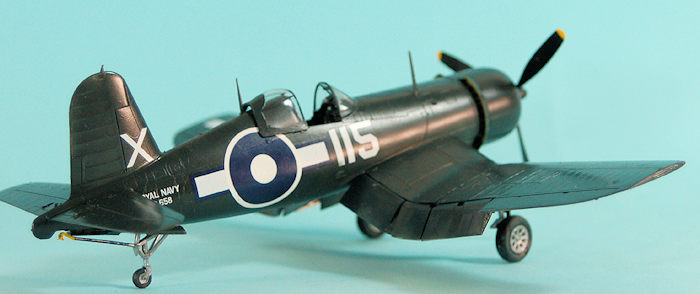 angkalan Brandon
in northern Sumatra. The carriers launched 92 Avengers and Fireflies escorted by
Hellcats of
Indomitable’s
1839 and 1844 Squadrons and Corsairs from
Victorious’
1834 and 1836 Squadrons.
angkalan Brandon
in northern Sumatra. The carriers launched 92 Avengers and Fireflies escorted by
Hellcats of
Indomitable’s
1839 and 1844 Squadrons and Corsairs from
Victorious’
1834 and 1836 Squadrons.
With the ships’ return to Trincomalee, the British Pacific Fleet began its move to the Pacific Theater, weighing anchor and heading east-southeast into the Indian Ocean on 16 January. It was planned that the four carriers of Admiral Vian’s Task Force 63 would make a final strike against the Indonesian oil refineries during their passage to Australia. The targets were the Palembang refineries at Pladjoe and Songei Gerong. Operation Meridian One, the Pladjoe strike, was flown on 24 January. Losses were heavier than on previous raids due to strong Japanese aerial opposition, with seven aircraft shot down over the target, while 25 aircraft - many damaged from anti-aircraft fire - were lost due to crash landings back aboard the carriers. Output at the refinery was cut in half for three months, with most of the oil in the storage tanks destroyed by fire. Operation Meridian Two was flown against Songei Gerong on 29 January. Enemy air opposition was strong and the FAA pilots claimed 30 Japanese planes shot down and another 38 destroyed on the ground, for the loss of 16 British aircraft. All production at the Soengi Gerong Refinery was stopped for two months and was never more than a quarter of what it had been before the attack over the rest of the war. At an overall cost of 25 aircraft lost in Operation Lentil and Operations Meridian One and Two, the Royal Navy had cut the production of aviation gasoline on Sumatra to 35 percent of its pre-attack production and it would never recover. The effects of the shortage on the Burma campaign in the final six months of war were dramatic. Coupled with Halsey’s South China Sea strikes, Japan was now virtually cut off from supplies of oil and gasoline, the major resource for which the Empire had gone to war in 1941 to control.
After moving up to Manus Atoll in March 1945, the BPF, operating as Task Force 57, joined Task Force 58 in April for Operation Iceberg, the invasion of Okinawa. Reinforced by HMS Formidable, the armored British carriers became the first line of defense against the kamikazes throughout May, with the carriers taking hits that would have put an American carrier out of action if not sinking it outright, and continuing operation.
In June, the British returned to Sydney for repair and replenishment, then rejoined Task Force 38 off the Japanese Home Islands as Task Force 37 for the final battles.
Lieutenant Robert Hampton Gray, RCNVR:
Lieutenant Robert
Hampton “Hammy” Gray, VC, DSC, is the most widely known Canadian naval aviator
from the Second World War. Born in Trail B.C., to John Balfor Gray a Boer War
veteran and his wife Wilhelmina Gray of Listowel, Ontario, Robert Hampton (Hammy
to his friends and family), was the oldest son in a family of three children. In
1936 he entered the University of Alberta and later transferred to the
University of British Columbia for Pre med studies. Abruptly at the end of the
1940 university term he decided to enlist in the armed forces with the Royal
Canadian Naval Volunteer Reserve (RCNVR) as a rati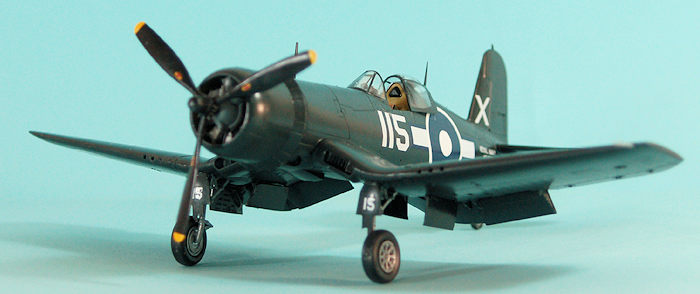 ng on loan to the Royal Navy
as a prospective officer cadet. In December 1940 he joined the Fleet Air Arm. He
soloed on 21 March 1941 and was sent to Canada for advanced training, and was
commissioned a Sub-Lt. That September. In 1942 he was sent to South Africa. On 6
August 1943, Gray was posted back to England and became senior pilot in 1841
Squadron, equipped with the Corsair II. 1841 was assigned to HMS
Formidable
which took part in Operation Goodwood, the Tirpitz strikes. He led the squadron
on two missions on 21 August 1944, flying flak suppression for the strike
aircraft. After a 40mm hit in his rudder, he returned to the ship and orbited
for 45 minutes waiting his turn to land rather than disrupt the landing pattern.
His gun camera film showed extreme close ups of the anti aircraft guns, and he
was heard to say "some dumb Canadian needed a good talking to". He Mentioned in
Despatches "for undaunted courage, skill and determination in carrying out
daring attacks on the Tirpitz".
ng on loan to the Royal Navy
as a prospective officer cadet. In December 1940 he joined the Fleet Air Arm. He
soloed on 21 March 1941 and was sent to Canada for advanced training, and was
commissioned a Sub-Lt. That September. In 1942 he was sent to South Africa. On 6
August 1943, Gray was posted back to England and became senior pilot in 1841
Squadron, equipped with the Corsair II. 1841 was assigned to HMS
Formidable
which took part in Operation Goodwood, the Tirpitz strikes. He led the squadron
on two missions on 21 August 1944, flying flak suppression for the strike
aircraft. After a 40mm hit in his rudder, he returned to the ship and orbited
for 45 minutes waiting his turn to land rather than disrupt the landing pattern.
His gun camera film showed extreme close ups of the anti aircraft guns, and he
was heard to say "some dumb Canadian needed a good talking to". He Mentioned in
Despatches "for undaunted courage, skill and determination in carrying out
daring attacks on the Tirpitz".
In May 1945, Formidable joined the BPF. 1841 and 1842 Squadrons were refitted with 20 new F4U 1D Corsair IVs. Formidable was part of Task Force 37 that joined the third Fleet off Japan in July. Hammy Gray took part in numerous strikes against Japanese targets in the Home Islands.
On 9 August, Gray was assigned a mission to strike Matsushima airfield with eight Corsairs. At the last minute, the mission was changed to seek out targets of opportunity since the airfield was already heavily damaged. Japanese ships in Onagawa Bay were the chosen target. All the ships in the bay were heavily armed and prepared for an air attack, while anti aircraft positions in the surrounding hills created a killing zone. Gray dove to attack the ocean escort vessel Amakusa. As he leveled out for his run, one of his two 500-lb bombs was shot away by a hail of cannon and machine gun fire from Amakusa, Minesweeper 33, Ohama and Sub Chaser 42. Gray scored a direct hit on Amakusa with the other bomb, which penetrated the engine room and triggered an massive explosion in the aft ammunition magazine which sank the ship in minutes. The other members of the flight reported seeing his aircraft enveloped in smoke and flame at an altitude of 50 feet roll to the right into the sea in an explosion of debris and water. The other seven Corsairs continued the attack and sank several other ships.
Robert Hampton Gray was one of sixteen Canadians awarded the British Victoria Cross during the Second World War and the the only one awarded to a member of the Royal Canadian Navy, and the last to be awarded to a Canadian as the Canadian Government had just recently created its own version of the Victoria Cross.
There is a statue of Robert Hampton Gray in Onagawa Bay, next to a memorial to the Japanese sailors killed there on 9 August. It is the only foreign military memorial in Japan.
| THE KIT |
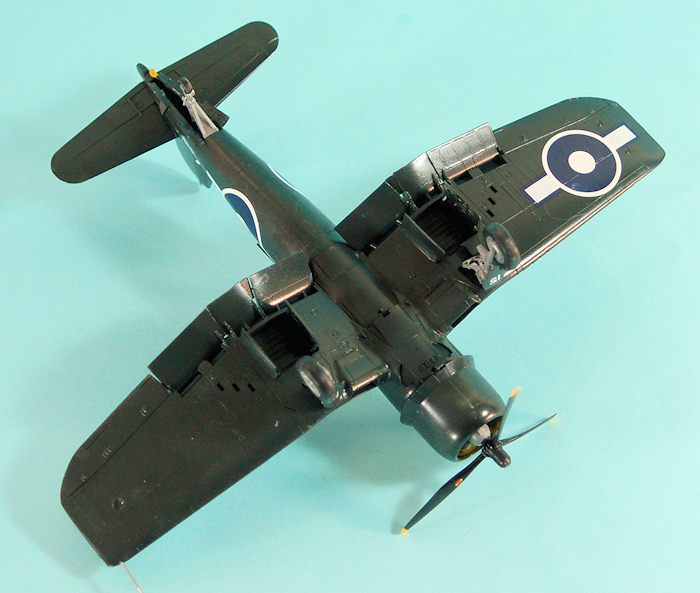 Tamiya’s Corsair
first appeared 20 years ago, as the F4U-1 “birdcage”. This was finally followed
in 1998 by the F4U-1A and a few months later the F4U-1D, which differ primarily
in the propeller and the addition of rocket stugs and pylons under the fuselage
for the F4U-1D. The kits are well-known for perfect fit and have been popular
with modelers since first released.
Tamiya’s Corsair
first appeared 20 years ago, as the F4U-1 “birdcage”. This was finally followed
in 1998 by the F4U-1A and a few months later the F4U-1D, which differ primarily
in the propeller and the addition of rocket stugs and pylons under the fuselage
for the F4U-1D. The kits are well-known for perfect fit and have been popular
with modelers since first released.
I recently found both the F4U-1A and F4U-1D kits at “bargain” prices at the LHS from a modeler’s estate sale and picked them up. I am currently writing a history of carrier operations during the last ten months of the Pacific War, which includes the operations of the British Pacific Fleet. I discovered I still had Hammy Gray’s markings on an old Aeromaster sheet in the Decal Dungeon, and decided to do that. Research revealed that the British Corsair IVs were early-production Goodyear FG-1Ds, with the earlier canopy of the F4U-1A and the earlier prop, so I used the F4U-1A kit for the conversion.
| CONSTRUCTION |
The primary difference for a British Corsair from an American Corsair is that the FAA removed the outer eight inches of the wingtips, giving the wing a “squared off” look. This modification is accomplished by cutting off the wingtip just outboard of the aileron, following the panel line there. A little reshaping with a sanding stick takes care of the rest.
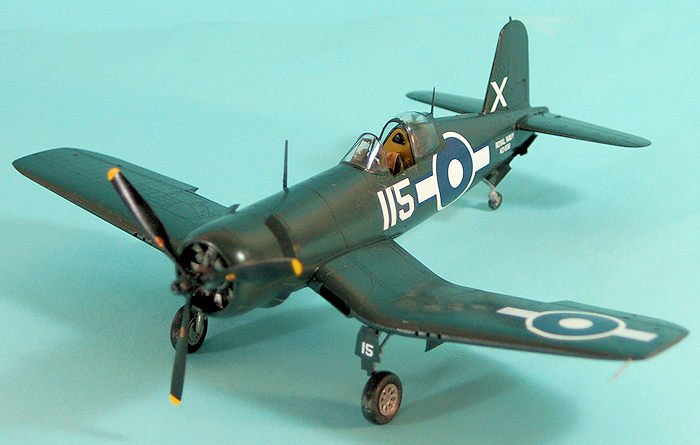 According to Bert
Kinzey’s Corsair in Detail and Scale, Goodyear Corsairs have a cockpit painted
Yellow Zinc Chromate in the “hell hole” and rear bulkhead, the sides of the side
panels and the seat in Interior Green, and the tops of the side panels and side
of the cockpit above the panels in flat black. I painted this all before
assembly. I also painted the interior of the cowling YZC, and detail painted the
engine parts.
According to Bert
Kinzey’s Corsair in Detail and Scale, Goodyear Corsairs have a cockpit painted
Yellow Zinc Chromate in the “hell hole” and rear bulkhead, the sides of the side
panels and the seat in Interior Green, and the tops of the side panels and side
of the cockpit above the panels in flat black. I painted this all before
assembly. I also painted the interior of the cowling YZC, and detail painted the
engine parts.
Assembly of the kit presents no difficulties. I assembled the cockpit and glued it in place in the left fuselage half, then glued the fuselage together. The wing is a little trickier if one plans to have the wings spread and careful fitting is necessary to get the outer wing aligned with the center section. The flaps are designed to be in the down position, and attempting to raise them creates too many problems. The wing and fuselage sub assemblies fit without problem. I then assembled the engine and fitted it in the cowling and attached that to the fuselage, using the cowling flaps open option.
| COLORS & MARKINGS |
The F4U-1D is easy.
It’s overall Glossy Sea Blue, including the interiors of the wheel wells and
gear doors, with the landing gear in aluminum lacquer as it came out of the
factory. I used Xtracrylix Glossy Sea Blue, and V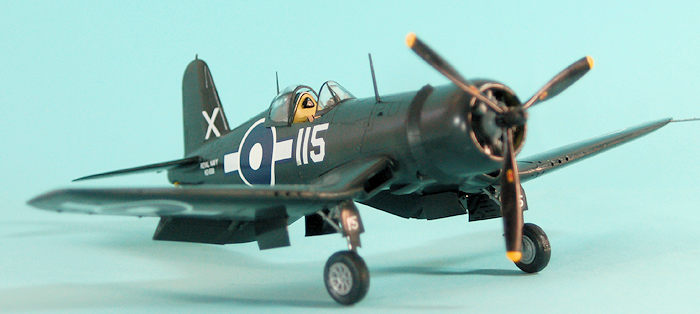 allejo Dull Aluminum for all
this. It’s a good idea to thin the GSB to about 60-40, to insure a nice smooth
finish.
allejo Dull Aluminum for all
this. It’s a good idea to thin the GSB to about 60-40, to insure a nice smooth
finish.
The decals went on without problem. Once they were set, I made the discovery that the fuselage markings are too large. The national insignia is about 10 percent too big, while the side number is about 20 percent too big, at least when compared with the only two photos of the airplane known to exist. Oh well, 99.99% of those who look at it will never know.
I gave the model an overall coat of Clear Satin varnish, then assembled the landing gear and attached it, unmasked the canopy and positioned it in the open position, and attached the prop.
| CONCLUSIONS |
It’s been close to fifteen years since I last did this kit, and it is still a pleasure to build, and practically guarantees a good result. Anyone from beginner on up can get a good model with a bit of care. The kit is the epitome of “Tamiya shake and bake.”
13 October 2016
Copyright ModelingMadness.com
Kit and decals courtesy of my wallet.
If you would like your product reviewed fairly and fairly quickly, please contact the editor or see other details in the Note to Contributors.